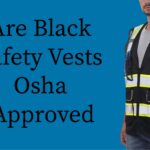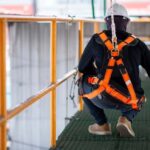Safety belts for construction are essential for protecting workers from falls and potential injuries on the job site. These belts are designed to secure individuals and provide support while working at heights, ensuring their safety and reducing the risk of accidents.
With safety as a top priority, construction workers must wear safety belts to comply with regulations and prevent any potential hazards. By using safety belts, workers can work more confidently and with peace of mind, knowing that they are protected from falls and other workplace accidents.
It is crucial for construction companies to prioritize and enforce the use of safety belts to maintain a safe working environment for their employees.
Read More: is industrial safety products legit
Importance Of Safety Belts In Construction Sites
Construction sites are inherently dangerous places, with numerous hazards that can pose a serious risk to the safety of workers. Among the most common accidents in construction are falls, which can lead to severe injuries or even fatalities. This is where safety belts play a crucial role in ensuring the well-being of workers on construction sites.
Statistics on construction site accidents and fatalities
Construction site accidents are alarmingly common. According to the Occupational Safety and Health Administration (OSHA), falls account for a significant percentage of fatalities in the construction industry. In fact, falls are one of the leading causes of death in construction, with thousands of workers experiencing fall-related injuries each year. Moreover, the Bureau of Labor Statistics (BLS) reports that fall-related accidents accounted for around 33% of all fatal construction accidents in recent years. These statistics highlight the urgent need for safety measures, such as safety belts, to prevent accidents and save lives.
The role of safety belts in preventing falls and injuries
Safety belts, also known as harnesses, are an essential tool for construction workers operating at heights. These belts are designed to protect workers by preventing falls and minimizing the risk of injuries in the event of a fall. They typically consist of a full-body harness, lanyard, and anchor point, all working together to secure individuals working on elevated surfaces. When properly worn and attached to a secure anchor point, safety belts distribute the force of a fall across the body, reducing the impact on any one specific area. This can significantly lower the risk of severe injuries or fatalities, giving workers a chance to avoid life-threatening situations.
Common hazards in construction sites
Construction sites present a multitude of hazards that can lead to accidents and falls. Some of the most common hazards include:
- Unprotected edges and floor openings
- Unstable or uneven surfaces
- Improperly constructed scaffolding or ladders
- Frequent movement and transportation of heavy equipment
- Working in adverse weather conditions
By wearing safety belts, workers can mitigate the risks associated with these hazards and ensure their safety while carrying out their tasks. Safety belts provide a much-needed layer of protection in unpredictable work environments, empowering workers to focus on their responsibilities with greater peace of mind. In conclusion, safety belts play a vital role in construction site safety by preventing falls, reducing the risk of injuries, and saving lives. These essential tools are crucial for workers operating at heights, providing them with the confidence and protection they need to work safely in perilous conditions.
Learn More: How To Put A Safety Harness On : A Step-By-Step Guide
Types Of Safety Belts And Harnesses
When it comes to construction safety, one of the most crucial pieces of equipment is the safety belt and harness. These essential tools are designed to protect workers from falls and minimize the risk of serious injuries. There are several types of safety belts and harnesses available, each offering its own unique features and benefits. In the following sections, we will explore three key types: full-body harnesses, safety belts with shock absorbers, and different types of buckles and connectors.
Full-body harnesses for comprehensive protection
Full-body harnesses provide comprehensive protection to construction workers, ensuring that their entire body is secured in case of a fall. These harnesses are designed to distribute the impact of a fall across the stronger areas of the body, such as the chest, back, and thighs. By evenly distributing the force, a full-body harness minimizes the risk of injury to vital organs and reduces the likelihood of fractures or other severe injuries.
Safety belts with shock absorbers to minimize impact force
In certain construction scenarios where falls are more likely, safety belts with shock absorbers are a recommended option. These belts are equipped with built-in shock absorbers that effectively reduce the impact force experienced by the worker during a fall. This feature is crucial in preventing serious injuries, especially in situations where falls from heights are common. Safety belts with shock absorbers are designed to absorb and dissipate the force, significantly minimizing the risk of injury to the worker.
Different types of buckles and connectors
Safety belts and harnesses come with a variety of buckles and connectors, each serving its own purpose. One common type is the tongue and buckle connector, which is easy to use and provides a secure fit. Another type is the quick connect buckle, which allows for fast and effortless connection and detachment. Additionally, there are specialized connectors such as carabiners, D-rings, and lanyards that are designed for specific applications or to meet certain safety standards.
The choice of buckle and connector should be based on the specific requirements of the construction project and the worker’s comfort and convenience. It is important to note that the proper fit and adjustment of safety belts and harnesses are crucial for optimal protection. Ill-fitting or improperly adjusted equipment can significantly compromise the effectiveness of the safety system. Each safety belt and harness should be individually adjusted to fit the worker comfortably and securely. Regular inspections and adjustments should be conducted to ensure that the equipment remains in proper working condition and provides the necessary protection.
Read More About: How to Master the Art of Roof Safety with a Harness
Safety Belt Inspection And Maintenance
Regular inspection for wear and tear
Regular inspection of safety belts for wear and tear is crucial to ensure their effectiveness. Over time, safety belts can become worn out or damaged, compromising their ability to provide protection. To inspect your safety belt, start by checking the overall condition of the straps. Look for any signs of fraying, cuts, or abrasions. Pay special attention to the stitching, as loose or missing stitches can weaken the belt’s integrity.
Checking for proper functioning of buckles and connectors
Properly functioning buckles and connectors are essential for the safe and secure use of safety belts. During your inspection, take the time to test the functionality of these components. Ensure that the buckles are securely fastened and can be easily released. Check for any signs of damage or deformation in both the male and female parts of the buckles. Similarly, examine the connectors to ensure they are fully functional and free from any defects.
Replacing damaged or worn-out components
If during your inspection, you find any damaged or worn-out components, it is crucial to replace them immediately. Using safety belts with compromised parts can put workers at risk. When replacing components, ensure that you use replacement parts that meet the manufacturer’s specifications. Avoid using makeshift repairs or non-original parts, as they may not provide the same level of safety and protection.
Cleaning and storing safety belts properly
Proper cleaning and storage of safety belts are essential to maintain their longevity and functionality. Cleaning should be done regularly to remove any dirt, debris, or contaminants that may compromise the belt’s performance. Follow the manufacturer’s guidelines for cleaning methods and avoid using harsh chemicals or solvents that may cause damage. After cleaning, make sure to store the safety belts in a dry and well-ventilated area, away from direct sunlight or extreme temperatures.
By regularly inspecting safety belts for wear and tear, checking the proper functioning of buckles and connectors, replacing damaged components, and cleaning and storing them correctly, you can ensure that construction workers are equipped with safe and effective safety belts. Prioritizing safety belt inspection and maintenance is essential in a construction environment where worker safety is of utmost importance.
Ensuring Compliance With Safety Belt Regulations
Construction sites can be hazardous environments, with workers required to perform tasks at heights or in precarious positions. In order to minimize the risk of falls and accidents, safety belts and harnesses are essential equipment that every worker must wear. To ensure compliance with safety belt regulations, it is important to understand the current safety standards and regulations for construction sites, the training and certification requirements for using safety belts, employer responsibilities for providing and maintaining safety equipment, and the potential consequences of non-compliance with safety regulations.
Overview of safety standards and regulations for construction sites
Various safety standards and regulations have been put in place to ensure the well-being of workers on construction sites. The Occupational Safety and Health Administration (OSHA) has developed specific guidelines and regulations to address fall protection, including the use of safety belts and harnesses. These regulations outline the minimum requirements that employers must follow to prevent falls and protect workers from serious injuries.
Training and certification requirements for using safety belts
Using safety belts requires proper training and certification to ensure they are used correctly and effectively. Workers should receive comprehensive training on how to properly inspect, put on, and adjust safety belts and harnesses. Additionally, they should be trained on how to identify potential hazards and how to safely use their safety equipment in various scenarios. Certification programs, such as the OSHA 30-hour Construction Industry Outreach Training Program, provide the necessary knowledge and skills for workers to use safety belts confidently and correctly.
Employer responsibilities for providing and maintaining safety equipment
Employers have a crucial role in complying with safety belt regulations by providing and maintaining adequate safety equipment for their workers. This includes ensuring that safety belts and harnesses are readily available, properly fitted, and inspected regularly for any signs of wear and tear. Employers are also responsible for providing ongoing training and refresher courses to keep workers updated on the latest safety practices and regulations.
Consequences of non-compliance with safety regulations
Non-compliance with safety belt regulations can have serious consequences for both workers and employers. Failure to provide and enforce the use of safety belts can result in severe injuries or fatalities in case of a fall. Additionally, employers who fail to adhere to safety regulations may face legal actions, monetary penalties, reputational damage, and increased insurance premiums. It is in the best interest of everyone involved to prioritize safety and ensure compliance with safety belt regulations.
Learn More About: How to Master Safety Harness And Lanyard Techniques
Safety Belt Training And Proper Usage
Importance of Comprehensive Training in Safety Belt Usage
Comprehensive training in safety belt usage is of utmost importance when it comes to maintaining a safe and secure working environment in the construction industry. With the potential risks and hazards present at construction sites, it is crucial that workers are well-trained and educated on the proper usage of safety belts.
Correct Techniques for Donning and Securing Safety Belts
Proper techniques for donning and securing safety belts are essential to ensure their effectiveness in protecting workers in the event of a fall. When wearing a safety belt, it should fit snugly around the waist, with the buckle properly fastened. The shoulder straps should be adjusted accordingly to provide proper support and prevent excessive slack.
Understanding Weight Limitations and Maximum Fall Distances
It is imperative for workers to understand the weight limitations of safety belts and the maximum fall distances they are designed to withstand. Exceeding these limits can compromise the effectiveness of the safety belt and put the worker at risk. Contractors and supervisors should provide clear guidelines and educate workers on the importance of adhering to these limitations for their own safety.
Proper Inspection and Storage after Use
Proper inspection and storage of safety belts after use is crucial to ensure their ongoing reliability and longevity. After each use, workers should carefully inspect their safety belts for any signs of wear or damage. Any concerns should be immediately reported to the appropriate personnel for further assessment or replacement. Safety belts should be stored in a clean and dry location, away from direct sunlight and corrosive substances, to prevent degradation and maintain their integrity.
Innovations In Safety Belt Technology
When it comes to keeping construction workers safe on the job, safety belts play a critical role in preventing accidents and minimizing injuries. Over the years, there have been significant advancements in safety belt technology, making them smarter and more effective than ever before.
Introduction of smart safety belts with built-in sensors>
One of the most notable innovations in safety belt technology is the introduction of smart safety belts with built-in sensors. These sensors are designed to detect movements and changes in the worker’s body position, providing real-time feedback and alerts. By monitoring the worker’s posture and movements, these smart safety belts can help prevent falls and other accidents.
Integration of communication devices and GPS technology>
Another exciting development in safety belt technology is the integration of communication devices and GPS technology. With the advancements in wearable technology, safety belts can now be equipped with communication devices such as two-way radios and GPS trackers. This allows workers to communicate with each other and supervisors instantly, enhancing coordination and response in case of emergencies.
Advances in shock-absorption systems>
Shock-absorption systems have also undergone significant improvements in recent years. Safety belts now feature advanced shock-absorption mechanisms that are more effective in reducing the impact of falls and sudden stops. These systems utilize innovative materials and designs to provide enhanced protection and comfort to workers, minimizing the risk of injuries.
Potential future developments in safety belt technology>
Looking ahead, the future of safety belt technology holds even more promising developments. Researchers and engineers are constantly exploring ways to enhance the functionality and effectiveness of safety belts. Some potential future developments include:
- Integration of biometric sensors to monitor vital signs and fatigue levels
- Incorporation of augmented reality (AR) technology to provide workers with real-time instructions and hazard warnings
- Development of self-adjusting safety belts that automatically adapt to the worker’s body movements
With these potential advancements, safety belts are set to become even more critical in ensuring the safety and well-being of construction workers.
Helpful Post for you: Are Black Safety Vests OSHA Approved
Safety Belt Programs And Best Practices
Safety Belt Programs and Best Practices Implementing comprehensive safety belt programs on construction sites is essential for ensuring the safety of workers and preventing accidents. By implementing these programs, construction companies can create a culture of safety and promote awareness among their workers. Regular safety meetings and inspections are also crucial to ensure compliance with safety belt usage. By recognizing and addressing common safety belt usage mistakes, companies can take proactive steps to protect their workers from potential hazards.
Implementing comprehensive safety belt programs on construction sites
Implementing comprehensive safety belt programs on construction sites is crucial for minimizing the risk of accidents and injuries. These programs should include clear guidelines on the proper usage and maintenance of safety belts. Additionally, construction companies should provide adequate training to their workers, ensuring that they know how to properly use and inspect their safety belts.
Encouraging a safety culture and promoting awareness among workers
Creating a safety culture is key to reducing accidents on construction sites. Construction companies should actively encourage their workers to prioritize safety by wearing safety belts at all times. This can be achieved through regular safety trainings and toolbox talks that emphasize the importance of safety belt usage. By fostering a safety culture, workers will be more aware of the hazards they face and take proactive measures to protect themselves.
Regular safety meetings and inspections to ensure compliance
Regular safety meetings and inspections are essential for maintaining compliance with safety belt usage. Companies should conduct frequent safety meetings to educate their workers on the importance of using safety belts and to address any concerns or questions they may have. Inspections should also be carried out to ensure that workers are abiding by the safety protocols and wearing their safety belts properly. This will help identify any non-compliance issues and allow for prompt corrective actions.
Recognizing and addressing common safety belt usage mistakes
It’s important to recognize and address common safety belt usage mistakes to ensure workers’ safety. Some common mistakes include wearing a safety belt incorrectly, not inspecting the belt for damage before use, or using an expired safety belt. By providing proper training and regular reminders, construction companies can help workers avoid these mistakes. Additionally, companies should establish protocols for reporting and addressing any safety belt issues or concerns, ensuring that workers have the necessary resources to rectify any potential problems.
Recommended for you: How Often Should You Replace Work Shoes
Frequently Asked Questions Of Safety Belts For Construction
What Is The Osha Standard For Body Belts?
The OSHA standard for body belts specifies safety requirements for workers to prevent falls.
What Is Safety Belt In Construction?
A safety belt in construction is a device worn to protect workers from falls off elevated surfaces.
What Is The Difference Between A Safety Belt And A Safety Harness?
A safety belt is worn around the waist, while a safety harness is worn over the shoulders and around the waist.
What Are The Standards For Safety Belts?
Safety belts must adhere to specific standards, ensuring they are secure and protective. These standards guarantee that the belts meet necessary safety requirements.
Conclusion
Safety belts play a crucial role in ensuring the well-being of construction workers. By providing a reliable form of protection, these belts reduce the risks associated with falls and accidents in the construction industry. Not only do they prevent injuries, but they also promote productivity and confidence among workers.
As a result, the implementation of safety belt protocols should be a top priority for construction companies. Ongoing training and regular equipment inspections are vital to maintain the effectiveness of safety belts. By prioritizing the use of safety belts, construction companies can demonstrate their commitment to the safety and welfare of their workers.
Together, with collective efforts and a focus on safety, we can strive towards a construction industry that values and safeguards the lives of its workers.















